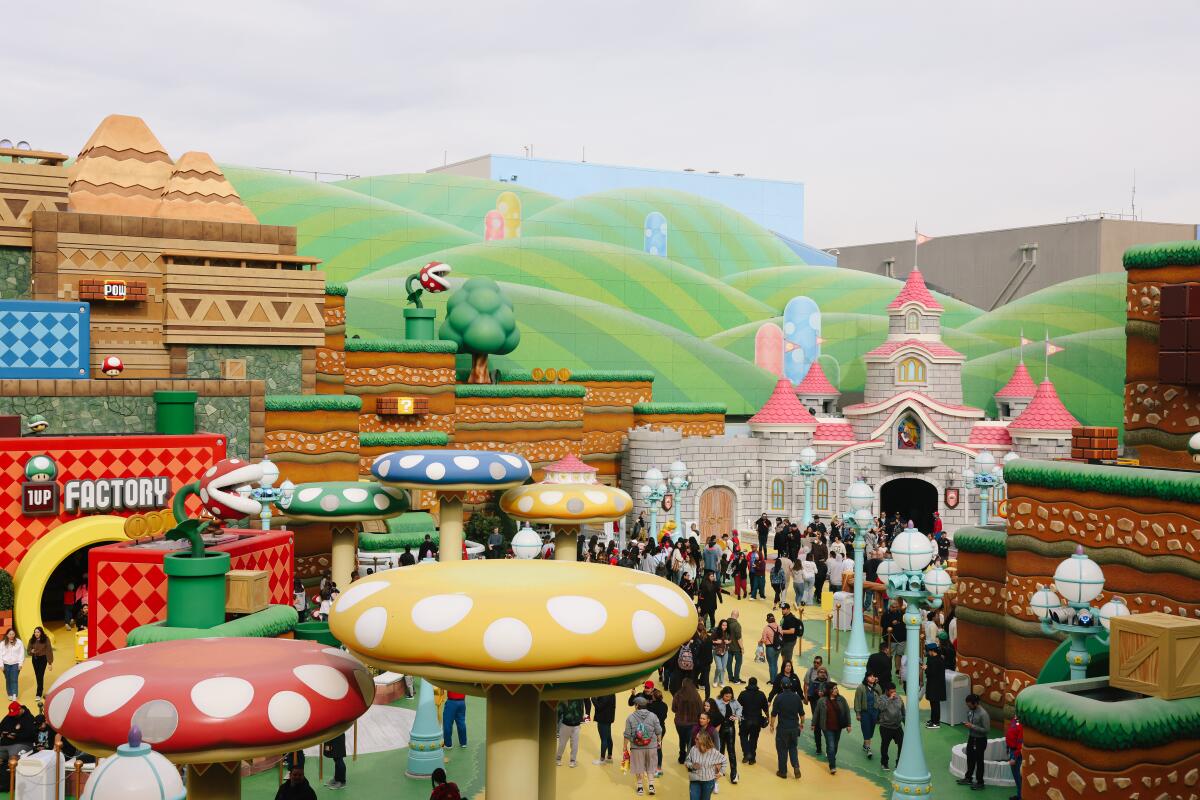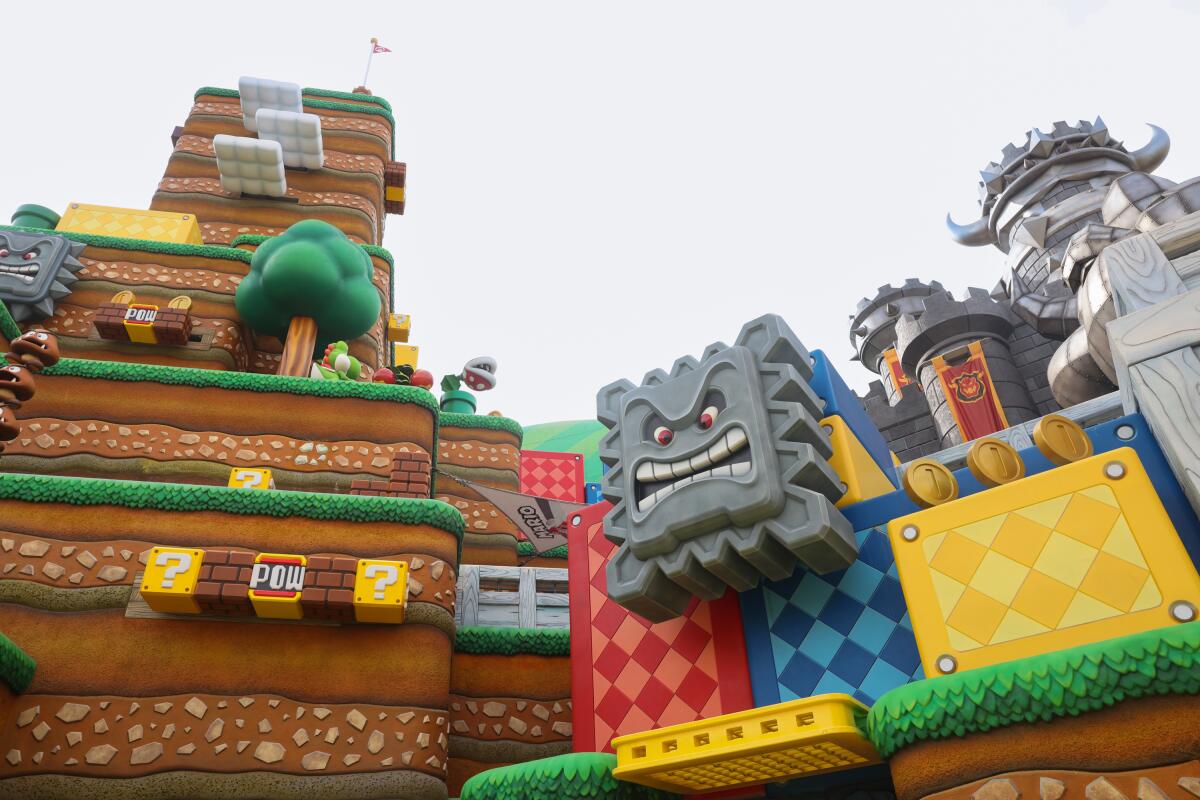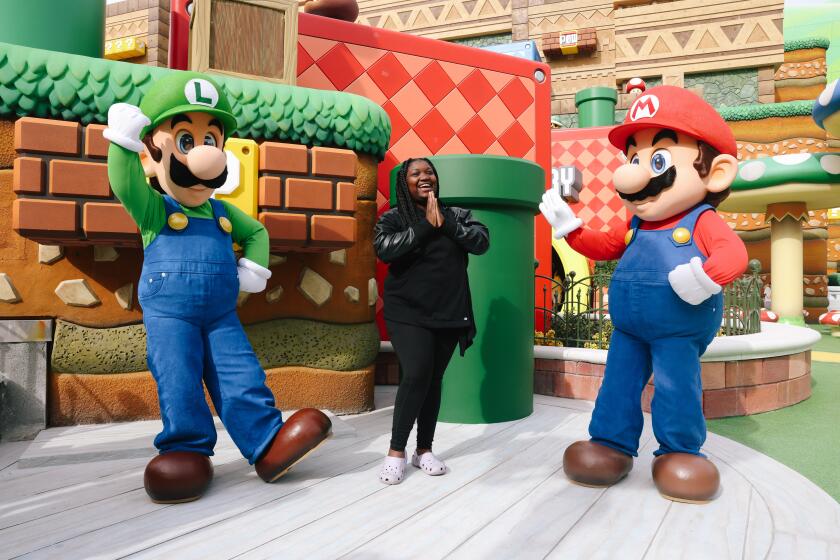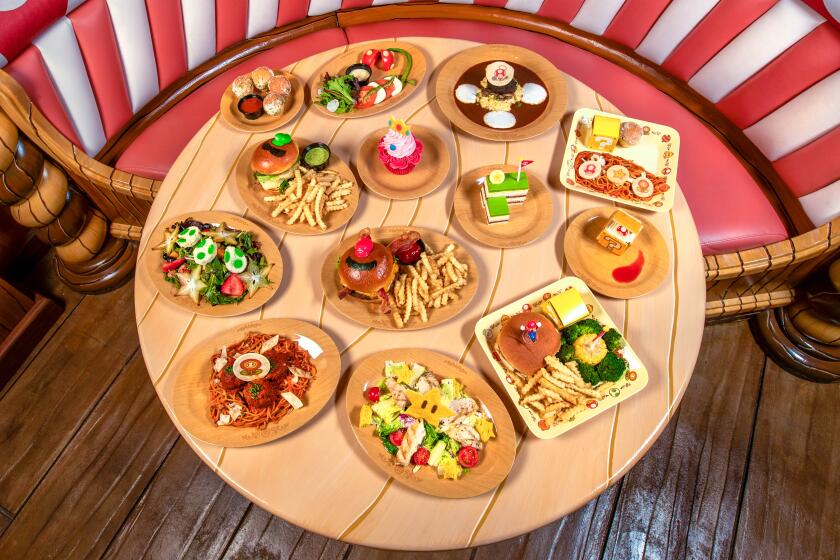Universal’s Super Nintendo World is the play-focused theme park land for our times

- Share via
A credit list into the hundreds — likely thousands — helped bring Universal Studios’ Super Nintendo World to life. And the details show it.
After walking through an oversize green warp pipe — and hearing the three-pronged digital zaps familiar to generations of “Super Mario Bros.” players — we’re in a brightly colored fantasy world that immediately feels interactive. Laid out like an obstacle course, with creatures, characters, moving platforms and mushrooms beckoning us to explore, everywhere we look we’re greeted with an inviting but loud contrast.
Plants chomp, a thumping, angry-faced block hovers and slams over a cave, and familiar-but-odd critters wander above us while our eyes adjust to an appealing clash of wintry and desert environments. We’re surrounded by brash digital colors, and yet Super Nintendo World feels made of this earth, as watercolor hills grace the entrance and sketch-like animations comprise some of the visuals.
As weird as all this may seem to those unfamiliar with the Mushroom Kingdom, the namesake land of the “Super Mario Bros.” games, it’s all presented in luminous, cheery tones that signal a sense of comfort. It’s larger-than-life mushrooms rather than trees that dot the center of the area, but they glisten and have a rubbery, bouncy sheen that beckons us closer and invites us to touch.
And for all the architecture, technology, engineering and landscape design behind Super Nintendo World, it’s rooted in the mind of one person: master game designer Shigeru Miyamoto.
This physical, real-world space that guests can now visit had its basis in the 8-bit games of the early 1980s, where pixel limitations meant Miyamoto and the team at Nintendo sought recognizable but off-kilter images to denote a sense of scale and fantasy. And Miyamoto’s own time in nature as a child played a part too.
“Looking back at my childhood experiences, the times I was running around, the times I was climbing things and went into dark areas — that was kind of trying to create the connection between my real-life experiences with the 8-bit world,” said Miyamoto via a translator. “So creating a dark space, or something you could climb to, those are the experiences we were trying to create within the limitations to make a game. Fast-forward to where we are now, those limitations are no longer there. What were limitations are just real.”
True-life inspiration became a fantasy interactive world, which has now come full circle to exist as a physical space, one housing an elaborate “Mario Kart”-inspired attraction, a triumphant creation where the tactile and the imaginary, built sets and the animated world, all spring to life on a track-driven ride that blurs the boundaries between game and reality. “Super Nintendo World” is not only the most game-focused theme park land in existence but a love letter to the medium that has, over the last 40 years, gradually come to dominate our lives and pop culture.

Nintendo’s own Switch video game console has sold more than 122 million units, making it the third-best-selling console ever, and Super Nintendo World arrives weeks before a new “Super Mario Bros.” film and at a time when HBO’s game-based “The Last of Us” is the most popular series on television.
But more than that, games and game-like trappings have gradually infiltrated many aspects of our lives. Romances start by swiping right on apps, friendships are maintained by “hearting” photos and posts — the giving of digital points to one another — and the tech world’s latest fascination is virtual chatbots that have the ability to toy with our emotions. Play takes many forms, and today it defines us.
Super Nintendo World just may be the most family-friendly and accessible rendition of melding the physical and the digital. Immediately upon entering, and exiting the castle of Princess Peach and the painterly hills behind it, we spy bright yellow blocks that invite us to whack them.
Play, as Super Nintendo World is evidence of, can surprise even the most jaded among us. And it can even bring a smile to expert game masters. Miyamoto is the most celebrated game designer of our time, having not only created Mario and Luigi and the “Super Mario Bros.” franchise but having crafted or led the designs of “Donkey Kong,” “The Legend of Zelda,” “Pikmin” and much more.
Universal Studios Hollywood’s Super Nintendo World -- home to the ride Mario Kart: Bowser’s Challenge -- promises to be the most interactive theme park land ever created.
“It’s not enough to just have it look real,” Miyamoto said of the land.
“But you have to have people of all ages, from grandkids to grandparents, be able to be in the park and engage and interact with the park. What I had imagined was maybe we can create a space where people can just kind of enjoy rolling around and hanging out.
“That evolved into this interactive world, so when the people at Universal created the blocks for us, and made it so you can hit the blocks — at first glance, it just seems like a very simple action. I was like, ‘Maybe it’s not going to be fun?’ But when I actually did it, I loved it. It made me so happy. That’s why the interactive elements of this theme park are so crucial to the whole experience.”
What hitting random blocks in “Super Nintendo World” does — aside from generating various lights and audio cues — is instantly remove us from the mindset that we are entering somewhere to engage with games and are instead venturing into a park full of play. That is, we are suddenly divorced from the idea that games mean competition, which can lead to someone thinking, “I can’t do that,” and are instead focused on a purer vision of play, one that allows us to be silly and let our guard down.
Super Nintendo World, like Miyamoto’s games, then becomes a land of curiosity: I wonder if I can hit this, look through that or go up there. Often, we can.
This extends even to the ride Mario Kart: Bowser’s Challenge, the first major implementation of augmented reality on a North American theme park attraction. While we move at a relatively modest pace along a track, our visors provide a digital makeover to the rather elaborate, blacklight-enhanced theatrical sets, which lead us above and underwater, into a haunted passageway and onto “Mario Kart’s” famed multicolor Rainbow Road. As we traverse the track we’ll acquire shells, which we can press a button to throw at our opponents, our digital pal Mario, the environments or other karts, all while real-time animation responds to our actions.

It’s a bit chaotic when one rides for the first time and is still getting acquainted with the attraction’s layout and its controls, but it can start to feel natural on the second ride-through. That’s because we aim by looking, simply focusing on what and where we want to toss a shell. And augmented reality combined with built sets allows the game to come to our world rather than place us in an attraction that moves us among screens. Smartly, the emphasis is on riding alongside Mario and his pals more than it is winning or losing, creating a sense of camaraderie.
“When we’re building games, a lot of people may think it’s something digital,” Miyamoto said. “All you really need is your screen and your fingers, and that encompasses all of what games have to offer. But I feel there’s more to it. It’s when that virtual experience that you’re having in the game is able to make a connection to real-life experiences that you had. That’s what results in people really enjoying the game and being touched and moved by the game.”
He adds, “That kind of sense of adventure or playfulness maybe fades away into the background as people grow older. So having this kind of physical space, we’re hoping, brings that memory back, brings that joy and sense of adventure into people.”
More than that, Super Nintendo World, like the best-designed theme park spaces — think Disneyland’s New Orleans Square or Star Wars: Galaxy’s Edge, Cars Land in Disney California Adventure, the entirety of Walt Disney World’s Animal Kingdom or Universal’s “Harry Potter”-themed lands — works because I believe it fills us with a sense of wonder, or what Berkeley psychology professor Dacher Keltner described as “awe.” We need it, as a reminder that we can come together in a shared space where design can welcome us, helping us feel a part of a greater whole.
Each time I’ve traversed the green warp pipe to enter Super Nintendo World I’ve wanted to pause. It’s as if an adjustment period is needed, to get acquainted with colors that look computer-generated, and to remember I’m in a place with its own set of rules. There to my left are clocks I can punch, and up ahead is a gray, monstrous castle that feels alive. Being amid such spectacle is a freeing sensation.
Keltner spoke in a recent interview with Berkeley’s alumni publication on the importance of awe: “We know awe reduces stress. Awe helps your immune system. We know awe makes you feel like you have more time. It makes you feel like you’re part of a community. I can walk across the Berkeley campus, be awestruck by the trees and I’m suddenly like, I have a great community, my colleagues are great. If you find a minute or two out of your day, go out to lunch, go watch a cloud for a minute, just see how it changes.”
At Universal Studios Hollywood, Super Nintendo World is officially opening. Here’s a rundown of every dish at the Super Mario Bros.-themed Toadstool Cafe.
Or, in the case of Super Nintendo World, watch a stack of Goombas sway as they walk, or admire the flagpole atop “Mount Beanpole,” a towering mountain filled with blocks we wish we could punch, vicious chomping Piranha Plants, inviting green spaces and zipping platforms that seem ripe for jumping.
“We create games with curiosity in mind,” Miyamoto said, pointing up toward Mount Beanpole and saying he wants guests on the ground floor to wonder how one can reach its peak and interact with all its moving parts (one can’t).
“But that kind of curiosity or interest is something we wanted to re-create here,” he said. “It’s just like in games, to have points of interest and making sure we provide something that’s of interest and is a reward to people’s curiosity.”
Beyond the Mario Kart: Bowser’s Challenge ride, there are a series of mini-games that dot the space, appearing naturally — embedded into the design of the land rather than staged in a more carnival-focused setup. The idea is we have entered a game world rather than a place to play games.
One has us turning a crank to fell a Goomba, one of those wobbly, mushroom-like creatures. Another has us punching a block to unleash a shell in the hopes of hitting a Koopa, a turtle-inspired adversary.
Some require participating with a larger group or strangers, such as one in which we are trying to turn off vintage-designed toy clocks. There is a final collective battle that involves full body participation, and one will need to purchase a $40 Power-Up Band to gain access.
There is an underlying narrative to the land, as guests are charged with reacquiring a stolen golden mushroom, and the final bout necessitates having completed three prior games with progress tracked via the wristband (but you can probably charm your way in).
My sense is that may fly over the heads of most guests who don’t stop to watch the animated sequence in the entry hall of Princess Peach’s castle. Yet I don’t think the plot is required knowledge to have a good time in Super Nintendo World.
The underlying unspoken thesis of the land, after all, is one that has defined humanity since its very beginning: Play, before story, builds connections.
More to Read
The biggest entertainment stories
Get our big stories about Hollywood, film, television, music, arts, culture and more right in your inbox as soon as they publish.
You may occasionally receive promotional content from the Los Angeles Times.













